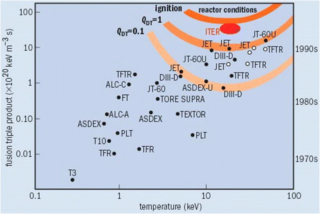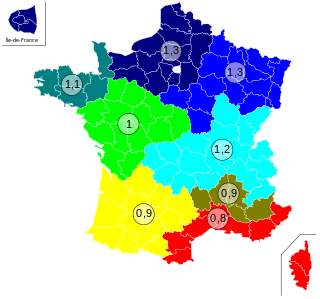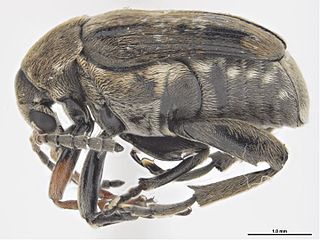In thermodynamics, the specific heat capacity of a substance is the heat capacity of a sample of the substance divided by the mass of the sample, also sometimes referred to as massic heat capacity. Informally, it is the amount of heat that must be added to one unit of mass of the substance in order to cause an increase of one unit in temperature. The SI unit of specific heat capacity is joule per kelvin per kilogram, J⋅kg−1⋅K−1. For example, the heat required to raise the temperature of 1 kg of water by 1 K is 4184 joules, so the specific heat capacity of water is 4184 J⋅kg−1⋅K−1.

Relative density, or specific gravity, is the ratio of the density of a substance to the density of a given reference material. Specific gravity for liquids is nearly always measured with respect to water at its densest ; for gases, the reference is air at room temperature. The term "relative density" is often preferred in scientific usage, whereas the term "specific gravity" is deprecated.

The Boltzmann constant is the proportionality factor that relates the average relative thermal energy of particles in a gas with the thermodynamic temperature of the gas. It occurs in the definitions of the kelvin and the gas constant, and in Planck's law of black-body radiation and Boltzmann's entropy formula, and is used in calculating thermal noise in resistors. The Boltzmann constant has dimensions of energy divided by temperature, the same as entropy. It is named after the Austrian scientist Ludwig Boltzmann.

Integrated pest management (IPM), also known as integrated pest control (IPC) is a broad-based approach that integrates both chemical and non-chemical practices for economic control of pests. IPM aims to suppress pest populations below the economic injury level (EIL). The UN's Food and Agriculture Organization defines IPM as "the careful consideration of all available pest control techniques and subsequent integration of appropriate measures that discourage the development of pest populations and keep pesticides and other interventions to levels that are economically justified and reduce or minimize risks to human health and the environment. IPM emphasizes the growth of a healthy crop with the least possible disruption to agro-ecosystems and encourages natural pest control mechanisms." Entomologists and ecologists have urged the adoption of IPM pest control since the 1970s. IPM allows for safer pest control.

Renal functions include maintaining an acid–base balance; regulating fluid balance; regulating sodium, potassium, and other electrolytes; clearing toxins; absorption of glucose, amino acids, and other small molecules; regulation of blood pressure; production of various hormones, such as erythropoietin; and activation of vitamin D.

Vigna subterranea is a member of the family Fabaceae. Its name is derived from the Bambara tribe. The plant originated in West Africa. As a food and source of income, the Bambara groundnut is considered to be the third most important leguminous crop in those African countries where it is grown, after peanut and cowpea. The crop is mainly cultivated, sold and processed by women, and is, thus, particularly valuable for female subsistence farmers.

The Lawson criterion is a figure of merit used in nuclear fusion research. It compares the rate of energy being generated by fusion reactions within the fusion fuel to the rate of energy losses to the environment. When the rate of production is higher than the rate of loss, the system will produce net energy. If enough of that energy is captured by the fuel, the system will become self-sustaining and is said to be ignited.

Thermal expansion is the tendency of matter to change its shape, area, volume, and density in response to a change in temperature, usually not including phase transitions.

A degree day is a measure of heating or cooling. Total degree days from an appropriate starting date are used to plan the planting of crops and management of pests and pest control timing. Weekly or monthly degree-day figures may also be used within an energy monitoring and targeting scheme to monitor the heating and cooling costs of climate controlled buildings, while annual figures can be used for estimating future costs.
The number of transfer units (NTU) method is used to calculate the rate of heat transfer in heat exchangers when there is insufficient information to calculate the log mean temperature difference (LMTD). In heat exchanger analysis, if the fluid inlet and outlet temperatures are specified or can be determined by simple energy balance, the LMTD method can be used; but when these temperatures are not available either the NTU or the effectiveness NTU method is used.

Agrotis ipsilon, the dark sword-grass, black cutworm, greasy cutworm, floodplain cutworm or ipsilon dart, is a small noctuid moth found worldwide. The moth gets its scientific name from black markings on its forewings shaped like the letter "Y" or the Greek letter upsilon. The larvae are known as "cutworms" because they cut plants and other crops. The larvae are serious agricultural pests and feed on nearly all varieties of vegetables and many important grains.

Paspalum scrobiculatum, commonly called Kodo millet or Koda millet, is an annual grain that is grown primarily in Nepal and also in India, Philippines, Indonesia, Vietnam, Thailand, and in West Africa from where it originated. It is grown as a minor crop in most of these areas, with the exception of the Deccan plateau in India where it is grown as a major food source. It is a very hardy crop that is drought tolerant and can survive on marginal soils where other crops may not survive, and can supply 450–900 kg of grain per hectare. Kodo millet has large potential to provide nourishing food to subsistence farmers in Africa and elsewhere.

Thaumatotibia (Cryptophlebia) leucotreta, commonly known as the false codling moth, orange moth, citrus codling moth or orange codling moth, is a moth in the family Tortricidae under the order of Lepidoptera. Larvae of the moth feed on a wide range of crops from cotton and macadamia nuts to Citrus species. The larvae have a less selective diet than the codling moth, which feeds primarily on temperate fruit crops.

Cajanus scarabaeoides is a flowering plant in the genus Cajanus. Of the 32 different species within the genus Cajanus, only one, C. cajan (pigeonpea), is cultivated. Cajanus scarabaeoides is the closest wild relative to C. cajan, and is one of the easiest wild species to cross with pigeonpea cultivars. C. scarabaeoides is found naturally in both temperate and tropical zones around the globe. This species has higher levels of drought tolerance, is found to have greater protein content, and has higher levels of resistance to insect pests compared to cultivated types. These genetic traits can be crossed with C. cajan to improve the crop's productivity. For subsistence farmers, this can reduce economic losses and drastically improve overall crop yield.

The population dynamics of pest insects is a subject of interest to farmers, agricultural economists, ecologists, and those concerned with animal welfare.
Chilo partellus, the spotted stalk borer or spotted stem borer, is a moth in the family Crambidae. It was described by Charles Swinhoe in 1885. It is found in India, Pakistan, Iran, Ethiopia, Lesotho, Madagascar, Malawi, South Africa, Sudan, Tanzania, Uganda and on Mayotte.

Bruchus rufimanus, commonly known as the broadbean weevil, broadbean beetle, or broadbean seed beetle is a leaf beetle which inhabits crops and fields, as well as some homes. It is a pest of faba beans. The adult beetles feed on pollen, while their larvae tunnel in seeds destroying crops and moving on to new ones once they dry out. The adult beetle, being one of the biggest of its genus, ranges from 3 to 5 mm in length.

The effects of climate change on agriculture can result in lower crop yields and nutritional quality due to drought, heat waves and flooding as well as increases in pests and plant diseases. Climate change impacts are making it harder for agricultural activities to meet human needs. The effects are unevenly distributed across the world and are caused by changes in temperature, precipitation and atmospheric carbon dioxide levels due to global climate change. In 2019, millions were already suffering from food insecurity due to climate change. Further, the predicted decline in global crop production is 2% - 6% with each decade. In 2019 it was predicted that food prices would rise by 80% by 2050. This will likely lead to increased food insecurity, disproportionally affecting poorer communities. A 2021 study estimated that the severity of heatwave and drought impacts on crop production tripled over the last 50 years in Europe – from losses of 2.2% during 1964–1990 to losses of 7.3% in 1991–2015.
Pierre Huglin developed a bioclimatic heat index for vineyards, the Huglin heat sum index in which the temperature sum over the temperature threshold of 10 °C is calculated and then summed for all days from beginning of April to end of September. The calculation uses both the daily average temperatures and the maximum temperatures and slightly modifies the calculated total according to latitude. Each grape variety needs a certain amount of heat in order to be cultivated successfully in the long term in a given area. The calculated heat sums, which are based on data from weather stations or from climate models, differ in that they are too low compared to the actual values in the vineyards. The index does not take into account e.g. thermally favoured hillsides where temperature values may be higher by about 1.5 °C to 2 °C.
The photothermal ratio (PTR), also named photothermal quotient, is a variable that characterizes the amount of light available to plants relative to the temperature level. It is used in plant biology to characterize the growth environment of plants.

























